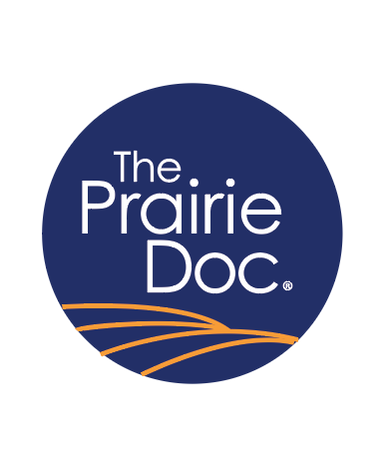|
Prairie Doc Perspective Week of June 23rd, 2024
“Urinary leakage in men and women” By Lauren Wood Thum, MD and Dennis Joseph Thum, MD As husband and wife urologists, we talk a lot about the urinary tract and how it affects our patients. In women, the most common urinary concern is incontinence, or the involuntary leakage of urine. There are several causes and many treatment options exist depending on the type. The two main types of urinary leakage in women are urge urinary incontinence and stress urinary incontinence. For women with urge incontinence, treatment is aimed at improving quality of life disrupted by overactive bladder. Overactive bladder is characterized by urinary urgency, frequency, waking up at night to urinate, with or without urge urinary incontinence. The most important first steps a patient can take to reduce bother include limiting caffeine intake, minimizing fluid intake (unless you have kidney stones, you do NOT need to drink 8 glasses of water a day), and urinating on a schedule every two hours or so while awake. The next step in treatment is medication. Many medications are no longer used due to unfavorable side effects of dry mouth, constipation and even dementia. Newer medications are much safer and better tolerated. Be sure to ask your doctor if your bladder medication is associated with an increased risk of memory loss and dementia. If medications fail, “third line therapy” is available. This includes tibial nerve stimulation, Botox bladder injections and an outpatient procedure to place a neuromodulation device (think of this as a pacemaker for the bladder). Treatment duration with Botox can last up to 9-12 months and neuromodulation is typically effective for 10-15 years or more, at which point a battery will need to be replaced. For women with stress incontinence, the mainstay of treatment is procedural, either with an in office urethral bulking agent or a surgically implanted mid-urethral sling. These procedures can be curative and greatly improve women’s quality of life. In men, the majority of leaking is due to prior prostate cancer surgery. This type of leakage with movement and activity is called male stress urinary incontinence. In addition to pelvic floor muscle exercises, procedural interventions exist as well. The mainstay of treatment is a procedure in which an artificial urinary sphincter is inserted. This is for men with the most severe leakage who are using many pads daily. It involves an inflatable cuff that encircles the urethra, a reservoir behind the pubic bone that stores the fluid when not around the urethral cuff and a pump placed in the scrotum to move the fluid from one location to another. Slings are also used in men with milder incontinence. In both instances, the goal is to get patients down to 1-2 light pads daily. Men can also experience urge incontinence and treatments are similar as for women; however, some differences do exist which can relate to enlarged prostate. The bottom line is, if you are suffering from urinary incontinence, many treatment options exist and we encourage you to speak with your doctor about these issues. -D. Joseph Thum and Lauren Wood Thum are both board certified Urologists at Urology Specialists in Sioux Falls, SD. Dr. Joseph Thum also sees patients in Worthington. In their free time, they enjoy the outdoors and spending time with their sons and German Shepherds. Follow The Prairie Doc® at www.prairiedoc.org and on Facebook featuring On Call with the Prairie Doc® a medical Q&A show providing health information based on science, built on trust, streaming live on Facebook most Thursdays at 7 p.m. central. Prairie Doc Perspective Week of June 16th, 2024
“Prescriptions for Parks” By Jill Kruse, DO Doctors write prescriptions for medications all the time. However, have you ever heard of a doctor prescribing a walk in the park? While this prescription will not fit in a bottle, it can pack some powerful health benefits. It may sound strange, but doctors actually can prescribe time outdoors to their patients with the help of a national program, ParkRx.org. This free online program can help a patient track their outdoor activity and discuss more outdoor exercise options with their doctor. In South Dakota, health care providers can contact the Department of Health to get a “Park Prescription” pad that is redeemable for a free 1 day pass to any South Dakota State Park or a discounted annual pass. Minnesota, Iowa, Wyoming, Montana, and Nebraska all have “Walk with a Doc” programs where you can meet at a public location to walk with a doctor and other health-minded individuals. Spending time in nature has been proven to help both physical and mental health. A review of 20 medical trials of participants who spent time in a forest environment found that their blood pressure was significantly lower after being in a forest than it was in a non-forest environment. Additionally, this improvement lasted for several days after being in the wooded area. These participants did not need to go for hikes, simply walking in, sitting in, or viewing the forest was able to give the participants lower blood pressures. This worked both for people with high blood pressure and normal blood pressure. It also showed improvement regardless of age as children, young adults, and older adults all had similar findings. One study found that children who spend more time outdoors have reduced rates of nearsightedness. Children who spent more time outdoors also have a lower risk of developing asthma according to another study. Increasing outdoor play also decreases BMI in preschoolers and lowers obesity in adults. Time outside has also been shown to be associated with improved sleep and sleep quality. Spending time outdoors has been linked to improving the immune system and decreasing stress. While spending time in State Parks and Forests is beneficial, even walking around the local neighborhood and being in an outdoor “green space” has shown to have health benefits. Of course, no medication is without side-effects. The great outdoors has bugs, you can get sunburned or there are uneven surfaces and loose gravel. So when you are going outside, remember to use sunscreen or wear a wide-brimmed hat and have bug repellent if going into areas where there are mosquitos and ticks. It is also important to have proper fitting shoes for your adventures to prevent blisters and slips or falls. With all the benefits of spending time outdoors, it just makes sense that doctors should write prescriptions for outdoor activities. So get out into nature to stay healthy out there! Jill Kruse, D.O. is part of The Prairie Doc® team of physicians and currently practices as a hospitalist in Brookings, South Dakota. Follow The Prairie Doc® at www.prairiedoc.org and on Facebook and Instagram featuring On Call with the Prairie Doc®, a medical Q&A show providing health information based on science, built on trust, on SDPB and streaming live on Facebook most Thursdays at 7 p.m. central. Prairie Doc Perspectives - Week of June 9th, 2024
“How to Prevent Sudden Death” By the late Richard P. Holm, MD My first experience with cardiopulmonary resuscitation was during the summer of 1969. I was an orderly in a Minneapolis intensive care unit (ICU) when my patient stopped breathing. I called for help and provided mouth-to-mouth breathing until the team arrived. Later the doctor told me I saved the patient’s life, further convincing me that medicine was my life’s purpose. Cardiopulmonary resuscitation (CPR) is the act of rhythmically pushing on the chest and breathing into the mouth of a person whose heartbeat and breathing has ceased. CPR can result in enough circulation to keep the victim alive until spontaneous circulation and breathing resumes. In 1740, the French described how mouth-to-mouth breathing sometimes saved drowned people, and, through the early 1900s, mouth-to-mouth breaths were given to bring lifeless newborns around. In the mid-1950s, two anesthesiologists, Dr. Elam and Dr. Safar, with help from the Red Cross, began promoting mouth-to-mouth resuscitation for adults discovered in cardiac arrest. In 1960, chest compressions were proven valuable in preserving circulation, especially to the brain, and even more important for survival than artificial respiration. In 1947 a Cleveland surgeon used an internal (open chest) defibrillator to save a 14-year-old boy, and in 1955, Boston cardiologist, Paul Zoll, developed the now popular external (on skin) defibrillator. Studies show that the defibrillator is even more important than chest compression. With available automated external defibrillators (AEDs) and education on how to perform CPR and use AED devices, we have even better outcomes. For those having a cardiac arrest, the sooner they get defibrillation, effective CPR, and a 911 call for help, the greater the chance of functional recovery. Out-of-hospital successful survival after CPR is about ten percent but increases to 35 percent when the arrest is witnessed and the victim is provided early defibrillation. The sad news is that more than 50 percent of those who could benefit will not have CPR because bystanders fear they might do something wrong. The big mistake is NOT TO TRY. Simple, first-level, CPR courses are available for anyone interested in every community and through the internet, while AED devices are popping up in almost every community gathering area. Please notice where they are placed. Trust me, if someone has a cardiac arrest, and you try to help, you might just save a life. The Late Dr. Richard P. Holm founded Prairie Doc Programming with his partner Joanie Holm, RN. Dr. Holm was dedicated to providing science based information to everyone. Follow The Prairie Doc® at www.prairiedoc.org and on Facebook and instagram featuring On Call with the Prairie Doc® a medical Q&A show celebrating its 22nd season of health information based on science, built on trust, streaming live on Facebook most Thursdays at 7 p.m. central. Prairie Doc® Perspectives for week of June 2, 2024
“Kindness is the Best Medicine” by Joanie Holm, RN, C.N.P. My name is Joanie Holm. I am a certified nurse practitioner in Brookings, South Dakota and I am the person fortunate to have been the life partner of the original Prairie Doc, Richard P. Holm, M.D. Rick and I were married for 40 years before his passing in March of 2020. During those wonderful decades together, if I could point to one powerful action that strengthened our relationship with each other, with our family, our community and with our patients, it would be the act of kindness. Thankfully, Rick was alive to see the recognition and formalization of kindness as an essential element of medical education. Medical schools across the country have started to offer courses on compassion and caring. One of the first to do so was the University of South Dakota Sanford School of Medicine. When Dr. Mary Nettleman was Dean of the USD medical school, she explained why the school embraced kindness as part of its core curriculum at the time. “People want a physician who is not only competent, but also kind, so we will work to elevate this value throughout the school. By approaching this intentionally, we hope that students will learn how important kindness is in medicine and how they can incorporate it into their everyday practice. A culture of kindness can make us exceptional,” said Nettleman. I celebrate this awareness and elevation of kindness in medical education and I salute educators for enriching their medical students in this way. Since Rick’s death, I have received many wonderful notes of condolence that have been very meaningful to me and my family. With permission from the author of one such letter, I share the following message which further illustrates kindness. Dear Mrs. Holm, I’m one of the people who knew your husband through his TV show, and I learned from him. I have cerebral palsy and sometimes it’s hard for people to understand me. One day, my mom and I were having dinner in Sioux Falls and you were seated close to us. When Dr. Holm walked by my table, I put my hand out and he stopped and talked to me. I wanted to tell him that we were praying for him and I will never forget how he made me feel. I have worked with many doctors and he was one of the best! My dear husband practiced kindness in all he did. Regardless of our profession, may we all embrace acts of kindness and stop to hold the outreached hand of a fellow human being. Joanie S. Holm, R.N., C.N.P. is co-founder and president of Healing Words Foundation that supports Prairie Doc® programming. Follow The Prairie Doc® at www.prairiedoc.org and on Facebook featuring On Call with the Prairie Doc® a medical Q&A show providing health information based on science, built on trust for 21 Seasons, streaming live on Facebook most Thursdays at 7 p.m. central. |
Archives
July 2024
Categories |
 RSS Feed
RSS Feed


